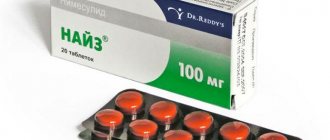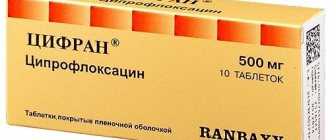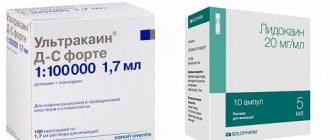Comparison of the effectiveness of Analgin and Baralgin M
The effectiveness of Analgin is quite similar to Baralgin M - this means that the ability of the drug substance to provide the maximum possible effect is similar.
For example, if the therapeutic effect of Analgin is more pronounced, then using Baralgin M even in large doses will not achieve this effect.
Also, the speed of therapy - an indicator of the speed of therapeutic action - Analgin and Baralgin M are approximately the same. And bioavailability, that is, the amount of a drug reaching its site of action in the body, is similar. The higher the bioavailability, the less it will be lost during absorption and use by the body.
Comparison of the effectiveness of Baralgin M and Pentalgin
The effectiveness of Baralgin M is quite similar to Pentalgin - this means that the ability of the drug substance to provide the maximum possible effect is similar.
For example, if the therapeutic effect of Baralgin M is more pronounced, then using Pentalgin even in large doses will not achieve this effect.
Also, the speed of therapy - an indicator of the speed of therapeutic action - Baralgin M and Pentalgin are approximately the same. And bioavailability, that is, the amount of a drug reaching its site of action in the body, is similar. The higher the bioavailability, the less it will be lost during absorption and use by the body.
Comparison of safety of Analgin and Baralgin M
The safety of a drug includes many factors.
At the same time, in Analgin it is quite similar to Baralgin M. It is important where the drug is metabolized: medicinal substances are excreted from the body either unchanged or in the form of products of their biochemical transformations. Metabolism occurs spontaneously, but most often involves major organs such as the liver, kidneys, lungs, skin, brain and others. When assessing the metabolism of Analgin, as well as Baralgin M, we look at which organ is the metabolizing organ and how critical the effect on it is.
The risk-benefit ratio is when the prescription of a drug is undesirable, but justified under certain conditions and circumstances, with the obligatory observance of caution in use. At the same time, Analgin does not have any risks when used, just like Baralgin M.
Also, when calculating safety, it is taken into account whether only allergic reactions occur or possible dysfunction of the main organs. In other matters, as well as the reversibility of the consequences of using Analgin and Baralgin M.
Comparison of Analgin and Baralgin
To determine which drug works better and more effectively, you must first compare them according to several basic criteria. Below is a comparative description of medicines.
Efficiency
Baralgin is more effective than Analgin. Although they have the same active ingredient, they act slightly differently. If you take Baralgin and Analgin in a certain therapeutic dose, the first will work more effectively. Even with an increased dosage of the second, it is not possible to achieve the same result.
Baralgin also “works” faster. Its active substance reaches the site faster and begins to inhibit the synthesis of prostaglandins.
Safety
Baralgin is safer. It accumulates in minimal quantities in target organs (kidneys, liver) and is quickly eliminated from the body naturally.
With Analgin, the elimination process is slower. In addition, a person more often experiences an allergic reaction to it - urticaria, bronchial asthma, anaphylactic shock and other manifestations.
Comparison of addiction between Analgin and Baralgin M
Like safety, addiction also involves many factors that must be considered when evaluating a drug.
So, the totality of the values of such parameters as “syndrome” in Analgin is quite similar to the similar values in Baralgin M. Withdrawal syndrome is a pathological condition that occurs after the cessation of the intake of substances that cause addiction or dependence into the body. And resistance is understood as initial immunity to a drug; in this it differs from addiction, when immunity to a drug develops over a certain period of time. The presence of resistance can only be stated if an attempt has been made to increase the dose of the drug to the maximum possible. At the same time, Analgin’s “syndrome” values are quite small, however, the same as for Baralgin M.
Comparison of safety of Baralgin M and Pentalgin
The safety of a drug includes many factors.
At the same time, in Pentalgin it is higher than in Baralgin M. It is important where the drug is metabolized: medicinal substances are excreted from the body either unchanged or in the form of products of their biochemical transformations. Metabolism occurs spontaneously, but most often involves major organs such as the liver, kidneys, lungs, skin, brain and others. When assessing the metabolism of Pentalgin, as well as Baralgin M, we look at which organ is the metabolizing organ and how critical the effect on it is.
The risk-benefit ratio is when the prescription of a drug is undesirable, but justified under certain conditions and circumstances, with the obligatory observance of caution in use. At the same time, Pentalgin has fewer risks when used than Baralgin M.
Also, when calculating safety, it is taken into account whether only allergic reactions occur or possible dysfunction of the main organs. In other matters, as well as the reversibility of the consequences of using Pentalgin and Baralgin M.
Comparison of side effects of Analgin and Baralgin M
Side effects or adverse events are any adverse medical event that occurs in a subject after administration of a drug.
Analgin has more adverse events than Baralgin M. This implies that the frequency of their occurrence is low with Analgin and low with Baralgin M. Frequency of manifestation is an indicator of how many cases of an undesirable effect from treatment are possible and registered. The undesirable effect on the body, the strength of influence and the toxic effect of drugs are different: how quickly the body recovers after taking it and whether it recovers at all. When using Analgin, the body's ability to recover faster is higher than that of Baralgin M.
Comparison of addiction between Baralgin M and Pentalgin
Like safety, addiction also involves many factors that must be considered when evaluating a drug.
So, the totality of the values of such parameters as “syndrome o” in Baralgin M is quite similar to the similar values in Pentalgin. Withdrawal syndrome is a pathological condition that occurs after the cessation of intake of addictive or dependent substances into the body. And resistance is understood as initial immunity to a drug; in this it differs from addiction, when immunity to a drug develops over a certain period of time. The presence of resistance can only be stated if an attempt has been made to increase the dose of the drug to the maximum possible. At the same time, in Baralgin M the meaning of the “syndrome” is quite small, however, the same as in Pentalgin.
Comparison of ease of use of Analgin and Baralgin M
This includes dose selection taking into account various conditions and frequency of doses. At the same time, it is important not to forget about the release form of the drug; it is also important to take it into account when making an assessment.
The ease of use of Analgin is approximately the same as that of Baralgin M. However, they are not convenient enough to use.
The drug ratings were compiled by experienced pharmacists who studied international research. The report is generated automatically.
Last update date: 2020-12-04 13:44:43
Comparison of side effects of Baralgin M and Pentalgin
Side effects or adverse events are any adverse medical event that occurs in a subject after administration of a drug.
Pentalgin has more adverse events than Baralgin M. This implies that the frequency of their occurrence is low with Pentalgin and low with Baralgin M. Frequency of manifestation is an indicator of how many cases of an undesirable effect from treatment are possible and registered. The undesirable effect on the body, the strength of influence and the toxic effect of drugs are different: how quickly the body recovers after taking it and whether it recovers at all. When using Pentalgin, the body’s ability to recover faster is higher than that of Baralgin M.
Baralgin® M
When treating patients receiving cytotoxic drugs, metamizole sodium should only be taken under medical supervision.
Anaphylactic/anaphylactoid reactions
When choosing a method of drug administration, it should be taken into account that parenteral use is associated with a higher risk of anaphylactic/anaphylactoid reactions.
The following conditions cause an increased risk of developing hypersensitivity reactions to metamizole sodium:
- bronchial asthma induced by taking analgesics;
- intolerance to analgesics such as urticaria or angioedema;
- complete or incomplete combination of bronchial asthma, recurrent polyposis of the nose and paranasal sinuses and intolerance to acetylsalicylic acid or other non-steroidal anti-inflammatory drugs (including a history);
- chronic urticaria;
- alcohol intolerance (increased sensitivity to alcohol), against the background of which, even when taking a small amount of certain alcoholic beverages, patients experience sneezing, lacrimation and severe redness of the face. Alcohol intolerance may indicate a previously unidentified syndrome of bronchial asthma associated with analgesics (aspirin asthma);
- intolerance or hypersensitivity to dyes (for example, tartrazine) or preservatives (for example, benzoates);
- a history of anaphylactic or other immunological reactions to other pyrazolones, pyrazolidines and other non-narcotic analgesics (see section “Contraindications”).
Before using the drug Baralgin® M, it is necessary to conduct a thorough interview with the patient. If it is determined that the patient was at particular risk of developing azaphylactoid reactions, the drug should be prescribed only after carefully weighing the possible risks and expected benefits. If a decision is made to use the drug Baralgin® M in such patients, strict medical monitoring of their condition will be required, and it is necessary to have means to provide them with emergency care in the event of the development of anaphylactic/anaphylactoid reactions.
In predisposed patients, anaphylactic shock may occur, so patients with bronchial asthma or atopy should be prescribed metamizole sodium with caution.
Severe skin reactions
Life-threatening skin reactions, such as Stevens-Johnson syndrome (SJS) and toxic epidermal necrolysis (TEN), have been described with the use of metamizole sodium. If symptoms of SJS or TEN (such as a progressive skin rash, often with blistering or mucosal lesions) occur, treatment with metamizole sodium should be discontinued immediately. It is prohibited to ever repeat treatment with the drug.
Patients should be informed about the subjective and objective symptoms of these diseases. They should be carefully monitored for skin reactions, especially during the first weeks of treatment.
Agranulocytosis
Agranulocytosis, which develops during treatment with metamizole, is of immunoallergic origin and lasts for at least one week. This reaction occurs very rarely and can be severe, life-threatening and even fatal. This reaction is not dose-related and may occur at any time during treatment.
All patients should be instructed to discontinue use of the drug and immediately consult their physician if the following subjective or objective symptoms possibly associated with neutropenia occur: fever, chills, sore throat, mouth ulcers. In case of development of neutropenia (number of neutrophils <1500 per mm3), it is necessary to immediately stop treatment, urgently perform a detailed general blood test and continue monitoring the blood composition until the number of formed elements returns to normal values.
Pancytopenia
If pancytopenia develops, treatment should be stopped immediately; complete blood count parameters should be monitored until they return to normal.
All patients should be instructed to immediately seek medical attention if subjective or objective symptoms suggestive of blood changes (eg, general malaise, infections, persistent fever, bruising, bleeding, pallor) occur during treatment with metamizole.
Isolated hypotensive reactions
Administration of metamizole sodium may cause isolated hypotensive reactions. These reactions may be dose dependent and occur more often after parenteral administration.
Acute abdominal pain
It is unacceptable to use the drug Baralgin® M to relieve acute abdominal pain (until the cause is determined).
Liver and kidney dysfunction
In patients with impaired liver or kidney function, Baralgin® M should be used only after consulting a doctor, since in these patients the rate of elimination of the drug is reduced.
Impact on laboratory results
In patients treated with metamizole, changes in the results of laboratory tests performed using the Trinder test and similar tests (for example, analysis of serum creatinine, triglycerides, HDL cholesterol and uric acid concentrations) were recorded.
Comparison of ease of use of Baralgin M and Tempalgin
This includes dose selection taking into account various conditions and frequency of doses. At the same time, it is important not to forget about the release form of the drug; it is also important to take it into account when making an assessment.
The ease of use of Baralgin M is approximately the same as Tempalgin. However, they are not convenient enough to use.
The drug ratings were compiled by experienced pharmacists who studied international research. The report is generated automatically.
Last update date: 2020-12-04 13:44:51









